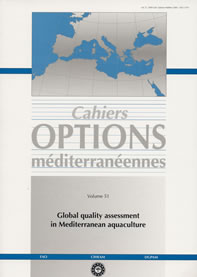| Article précédent | p. 55-61 | Article suivant |
Quality in harvesting and post-harvesting procedures - influence on quality. Fish freshness and quality assessment for sea bass and sea bream
The rapid development of finfish mariculture has led to declining prices, thus changing the image of these fish from 'prestigious fish' to 'common fish'. Big supermarket chains have conquered a large part of the fresh fish trade, replacing wholesalers and fishmongers. They ask for continuous and punctual deliveries and a uniform qualitative standard. Assuring high and certified quality will help get through the present difficult period. The HACCP assures one of the primary qualities fish must have as foodstuff: safety. Other qualities are just as important: appearance, shape, brightness, freshness, shelf life, etc. Rearing the fish in clear water and adopting a proper feeding regime, corresponds to accurate farming which can prove fruitless if OSP (Operative Standard Procedures) are not closely followed in harvesting, slaughtering, preparation and transport.
- [ Afficher ]
- [ Télécharger ]
- [ Exporter la citation ]
Vous pouvez télécharger la citation au format :
- [ Imprimer ]
-
Mots-clés
AQUACULTURE, BAR, DORADE, METHODE DE PECHE, QUALITECiter cet article
Caggiano M. Quality in harvesting and post-harvesting procedures - influence on quality. Fish freshness and quality assessment for sea bass and sea bream. Global quality assessment in Mediterranean aquaculture. Zaragoza : CIHEAM, 2000. p. 55-61. (Cahiers Options Méditerranéennes; n. 51). Workshop of the CIHEAM Networks on Technology of Aquaculture in the Mediterranean (TECAM) and Socio-Economic and Legal aspects of Aquaculture in the Mediterranean, 1999/11/29-1999/12/01, Barcelona (Spain). http://om.ciheam.org/om/pdf/c51/00600291.pdf



